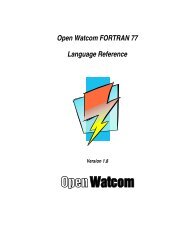Open Watcom Developer's Guide - HEAnet Mirror Service
Open Watcom Developer's Guide - HEAnet Mirror Service
Open Watcom Developer's Guide - HEAnet Mirror Service
Create successful ePaper yourself
Turn your PDF publications into a flip-book with our unique Google optimized e-Paper software.
Introduction<br />
in mid-1990s. Around 1993-1996, nearly all DOS games were developed with <strong>Watcom</strong> C,<br />
including famous titles such as DOOM, Descent or Duke Nukem 3D.<br />
<strong>Watcom</strong> International, Inc. had other successful products besides its highly acclaimed<br />
compilers. VX-REXX was a popular GUI RAD tool for OS/2 and <strong>Watcom</strong> SQL was a<br />
cross-platform "embeddable" SQL database.<br />
In mid-1990s, <strong>Watcom</strong> International, Inc. was acquired by PowerSoft, the maker of Power++,<br />
PowerDesigner and other GUI RAD tools for the Windows platform. PowerSoft used<br />
<strong>Watcom</strong> compiler technology as a back-end for their GUI tools besides continuing to market<br />
and develop existing <strong>Watcom</strong> tools.<br />
PowerSoft itself had merged with Sybase, Inc. in 1994. PowerSoft’s development tools<br />
nicely complemented Sybase’s database servers. Sybase was also interested in <strong>Watcom</strong> SQL<br />
which was enhanced and turned into Sybase SQL Anywhere.<br />
Sybase continued to sell <strong>Watcom</strong> C/C++ and FORTRAN compilers version 11 but it was<br />
obvious that Sybase couldn’t compete with Microsoft in the languages market. Sybase<br />
decided to end-of-life the <strong>Watcom</strong> compilers effective 2000.<br />
But that’s not the end of the story. Many customers did not want to give up the <strong>Watcom</strong><br />
compilers because there was no suitable replacement in many areas. One of these customers<br />
was Kendall Bennett of SciTech Software, Inc. SciTech entered into negotiations with Sybase<br />
and in an unprecedented move, Sybase agreed upon open sourcing the <strong>Watcom</strong> compilers and<br />
tools. One of the reasons why this was possible at all was the fact that <strong>Watcom</strong> had very little<br />
reliance on third-party tools and source code and had developed practically everything<br />
in-house, from YACC to IDE.<br />
The process of opening the source was longer than originally anticipated (all software related<br />
projects tend to work out this way for some inexplicable reason) but in the first half of 2002,<br />
the source was finally made available under the Sybase <strong>Open</strong> <strong>Watcom</strong> Public License version<br />
1.0.<br />
1.2 <strong>Guide</strong>d Tour<br />
This section will take you on a guided tour of the <strong>Open</strong> <strong>Watcom</strong> source tree, presenting an<br />
overview of its structure and highlighting some of the more memorable sights.<br />
The <strong>Open</strong> <strong>Watcom</strong> directory structure mostly mirrors the layout used by the <strong>Watcom</strong>/Sybase<br />
build server but it has been cleaned up, straightened out and unified, although there still may<br />
be some warts.<br />
4 <strong>Guide</strong>d Tour
















